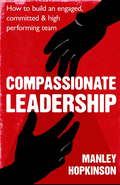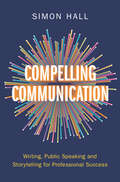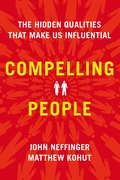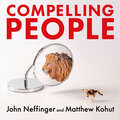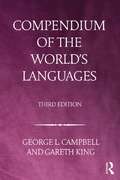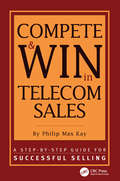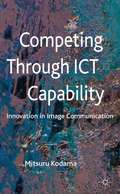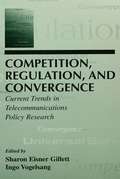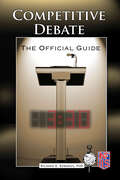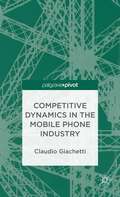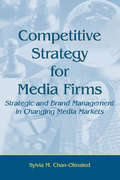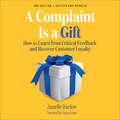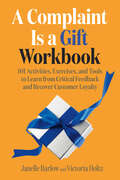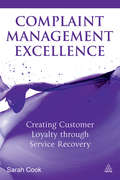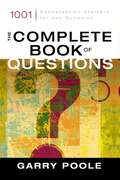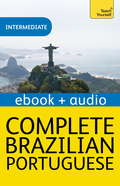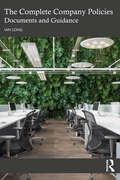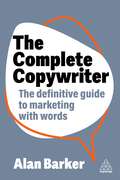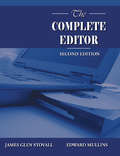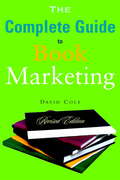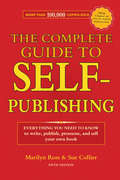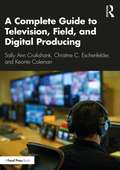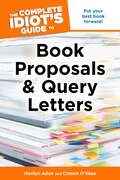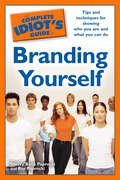- Table View
- List View
Compassionate Leadership: How to create and maintain engaged, committed and high-performing teams
by Manley HopkinsonForcing compliance is easy. Anyone can 'make' another do a task or a job. It will get done, but when, and to what standard? High performance and, more importantly, sustained high performance can only come from engagement with and commitment to the job in hand. This book will introduce you to the art of compassionate leadership - the art of getting the best for and out of people through the fulfilment of self-worth. It will show leaders how to give their teams a real sense of purpose and direction in order to motivate and inspire them to perform at a high level. To illustrate his message, author Manley Hopkinson draws on his background as a board member of companies including ATLAS Consortium and Hewlett Packard Defence UK, his career as an inspirational speaker and his adventure experiences as skipper in the BT Global Challenge (a round the world yacht race) and The Polar Race (an expedition style race to the Magnetic North Pole).
Compelling Communication
by Simon HallDo your communication skills let you down? Do you struggle to explain and influence, persuade and inspire? Are you failing to fulfil your potential because of your inability to wield words in the ways you'd like? This book has the solution. Written by a University of Cambridge Communication Course lead, journalist and former BBC broadcaster, it covers everything from the essentials of effective communication to the most advanced skills. Whether you want to write a razor sharp briefing, shine in an important presentation, hone your online presence, or just get yourself noticed and picked out for promotion, all you need to know is here. From writing and public speaking, to the beautiful and stirring art of storytelling, and even using smartphone photography to help convey your message, this invaluable book will empower you to become a truly compelling communicator.
Compelling People: The Hidden Qualities That Make Us Influential
by John Neffinger Matthew Kohut'This is not just another pop-psych book: it's the first book to capture and share the insights from all the recent groundbreaking research on how we judge and persuade each other. And it translates that into simple, practical terms anyone can use to build more effective relationships at the office or home' Amy CuddyHOW PEOPLE JUDGE YOU - AND HOW TO COME OUT LOOKING GOOD Everyone wants to know how to be more influential. But most of us don't really think we can have the kind of magnetism or charisma that we associate with someone like Bill Clinton or Oprah Winfrey unless it comes naturally. In Compelling People - now required reading and Harvard Business School - John Neffinger and Matthew Kohut show that this isn't something we have to be born with, it's something we can learn. They trace the path to influence through a balance of strength and warmth. Each seems simple, but only a few of us figure out the tricky task of projecting both at once. Drawing on cutting-edge social science research as well as their own work with Fortune 500 executives, members of Congress, TED speakers and Nobel Prize winners, Compelling People explains how we size each other up - and how we can learn to win the admiration, respect, and affection we desire.
Compelling People: The Hidden Qualities That Make Us Influential
by John Neffinger Matthew Kohut'This is not just another pop-psych book: it's the first book to capture and share the insights from all the recent groundbreaking research on how we judge and persuade each other. And it translates that into simple, practical terms anyone can use to build more effective relationships at the office or home' Amy CuddyHOW PEOPLE JUDGE YOU - AND HOW TO COME OUT LOOKING GOOD Everyone wants to know how to be more influential. But most of us don't really think we can have the kind of magnetism or charisma that we associate with someone like Bill Clinton or Oprah Winfrey unless it comes naturally. In Compelling People - now required reading at Harvard Business School - John Neffinger and Matthew Kohut show that this isn't something we have to be born with, it's something we can learn. They trace the path to influence through a balance of strength and warmth. Each seems simple, but only a few of us figure out the tricky task of projecting both at once. Drawing on cutting-edge social science research as well as their own work with Fortune 500 executives, members of Congress, TED speakers and Nobel Prize winners, Compelling People explains how we size each other up - and how we can learn to win the admiration, respect, and affection we desire.
Compendium of the World's Languages
by George L. Campbell Gareth KingThis third edition of Compendium of the World’s Languages has been thoroughly revised to provide up-to-date and accurate descriptions of a wide selection of natural language systems. All cultural and historical notes as well as statistical data have been checked, updated and in many cases expanded. Presenting an even broader range of languages and language families, including new coverage of Australian aboriginal languages and expanded treatment of North American and African languages, this new edition offers a total of 342 entries over nearly 2000 pages. Key features include: Complete rewriting, systematization and regularisation of the phonology sections Provision of IPA symbol grids arranged by articulatory feature and by alphabetic resemblance to facilitate use of the new phonology sections Expansion of morphology descriptions for most major languages Provision of new illustrative text samples Addition of a glossary of technical terms and an expanded bibliography Comparative tables of the numerals 1-10 in a representative range of languages, and also grouped by family Drawing upon a wealth of recent developments and research in language typology and broadened availability of descriptive data, this new incarnation of George Campbell’s astounding Compendium brings a much-loved survey emphatically into the twenty-first century for a new generation of readers. Scholarly, comprehensive and highly accessible, Compendium of the World’s Languages remains the ideal reference for all interested linguists and professionals alike.
Compete and Win in Telecom Sales: A Step-by -Step Guide for Successful Selling
by Philip Max KayFor anyone ready to launch a successful career in sales for telecom equipment, services and technologies, or for veterans ready to break through to a higher level, this book provides a practical eight-step program for successful selling.
Competing through ICT Capability
by Mitsuru KodamaProposes that video communications tools are a form of infrastructure that enhance the creation of new knowledge which transcends space and time in business activities. Illustrates that the dynamic relationship of four elements of ICT capability promote the formation of business networks and the development of knowledge communities.
Competition, Regulation, and Convergence: Current Trends in Telecommunications Policy Research (LEA Telecommunications Series)
by Sharon Eisner Gillett Ingo VogelsangThe telecommunications industry has experienced dynamic changes over the past several years, and those exciting events and developments are reflected in the chapters of this volume. The Telecommunications Policy Research Conference (TPRC) holds an unrivaled place at the center of national public policy discourse on issues in communications and information. TPRC is one of the few places where multidisciplinary discussions take place as the norm. The papers collected here represent the current state of research in telecommunication policy, and are organized around four topics: competition, regulation, universal service, and convergence. The contentious competition issues include bundling as a strategy in software competition, combination bidding in spectrum auctions, and anticompetitive behavior in the Internet. Regulation takes up telephone number portability, decentralized regulatory decision making versus central regulatory authority, data protection, restrictions to the flow of information over the Internet, and failed Global Information Infrastructure initiatives. Universal service addresses the persistent gap in telecommunications from a socioeconomic perspective, the availability of competitive Internet access service and cost modeling. The convergence section concentrates on the costs of Internet telephony versus circuit switched telephony, the intertwined evolution of new services, new technologies, and new consumer equipment, and the politically charged question of asymmetric regulation of Internet telephony and conventional telephone service.
Competitive Debate: The Official Guide
by Richard EdwardsThe bible for debaters and their coaches. Nearly every high school and college in America has a debate club and/or a debate team. There are hundreds of competitions at the county and state level, culminating in heated national competitions. Yet, at many high schools and colleges, coaches are drawn from the history or English departments with little or no experience in the highly structured procedures of this popular discipline. And while competitive debate has been growing each year as a prime academic activity, there have been no popular handbooks to help students and coaches prepare for contests effectively and efficiently. Practical and authoritative, this guide includes not only tips and guidelines for effective preparation and delivery, but full-length, actual transcripts of successful competitions in each format. Endorsed by the two national governing bodies for competitive debate—the National Federation of State High School Associations and the National Forensic League—and priced for the budget-conscious student and high school teacher alike, Competitive Debate: The Official Guide is set to become the instructional &“bible&” for tens of thousands of present and future debaters and their coaches. Inside, Dr. Richard Edwards—award-winning debate coach, professor, former competitive debate judge, and author—leads readers through the three popular formats of competitive debate: • Policy Debate • Lincoln-Douglas Debate • Public Forum Debate
Competitive Dynamics in the Mobile Phone Industry
by Claudio GiachettiThis book explores which kind of competitive moves and countermoves have been taken by mobile phone vendors like Nokia, Samsung, Motorola and Apple, as well as emerging rivals from developing countries, to defend their competitive position over the industry life cycle, and which factors have driven these actions.
Competitive Strategy for Media Firms: Strategic and Brand Management in Changing Media Markets (Routledge Communication Series)
by Sylvia M. Chan-OlmstedCompetitive Strategy for Media Firms introduces the concepts and analytical frameworks of strategic and brand management, and illustrates how they can be adapted according to the characteristics of distinct media products. Working from the premise that all media firms must strategize in response to the continuing evolution of new media, author Sylvia M. Chan-Olmsted offers applications of common business approaches to the products and components of the electronic media industry, and provides empirical examinations of broadcast, multichannel media, enhanced television, broadband communications, and global media conglomerate markets. This insightful and timely volume provides a thorough review of current concepts and industry practices, and serves as an essential primer for the application of business models in media contexts. As a realistic and integrated approach to media industry studies, this volume has much to offer researchers, scholars, and graduate students in media economics and management, and will be an important reference for industry practitioners.
A Complaint Is a Gift: How to Learn from Critical Feedback and Recover Customer Loyalty
by Janelle BarlowThe third edition of this bestseller (over 275,000 copies sold) builds on the tested formula that helps organizations recognize the value of complaints using updated examples and concepts in the age of COVID-19. The first edition of A Complaint Is a Gift introduced the revolutionary notion that customer complaints are not annoyances to be dodged, denied, or buried but are instead valuable pieces of feedback-not to mention your best bargain in market research. Complaints provide a feedback mechanism that can help organizations rapidly and inexpensively strengthen products, service style, and market focus. Most importantly, complaints that are well received create customer loyalty.This new edition condenses the tried and true eight-step formula into a tighter, more efficient three-step formula. From her work with clients, the author has updated industry-specific complaint examples and added in new concepts, such as a process that enables employees to handle complaints with increased emotional resilience-something that is sorely needed since dealing with increasingly difficult customers is a common occurrence in the wake of the COVID-19 pandemic. Handling complaints doesn't have to be a negative, soul-crushing experience. Janelle Barlow gives the right tools to treat each of them as a source of innovative ideas that can transform your business.
A Complaint Is a Gift Workbook: 101 Activities, Exercises, and Tools to Learn from Critical Feedback and Recover Customer Loyalty
by Janelle Barlow Victoria HoltzBased on the bestselling A Complaint Is a Gift (over 275,000 copies sold), this accompanying workbook offers actionable tools that help individuals and organizations transform even the most extreme complaints into gifts that drive their business forward.A Complaint Is a Gift introduced the revolutionary notion that customer complaints are not annoyances to be dodged, denied, or buried but are instead valuable pieces of feedback-not to mention your best bargain in market research. Complaints provide a feedback mechanism that can help organizations rapidly and inexpensively strengthen products, service style, and market focus. Most importantly, complaints that are well received create customer loyalty.Built to be interactive and immersive, the workbook teaches a set of practices, approaches, and tools that anyone can use to navigate fraught customer-facing interactions. It allows readers to practice Janelle Barlow's updated, more efficient three-step formula and enables employees to handle complaints with increased emotional resilience rather than taking them as personal attacks. A Complaint Is a Gift Workbook is packed with the necessary tools to view and treat complaints as a source of innovative ideas that can transform your business.
Complaint Management Excellence: Creating Customer Loyalty through Service Recovery
by Sarah CookAcross the global economy, customers' expectations are continually rising - but many companies fail to deliver against those expectations. With the rise in social media, customers are becoming more vocal in expressing any dissatisfaction, which can both lose existing customers and alienate potential new ones. Complaint Management Excellence provides practical advice, tools and techniques for managers to adopt when managing any complaints that come into their organisation. In order to arrive at a culture where complaints are welcomed, the underlying values, processes, structure, strategy and people within an organization all need to be aligned with, and respect, customer needs. Not only does this improve the long-terms prospects for the company itself, but can have a tremendous knock-on effect in terms of boosting employee morale and engagement. With case studies from companies as diverse as John Lewis, Waitrose, DHL, Hilton Hotels, the Starwood group (including Four Seasons and Ritz Carlton hotels) and BT, Complaint Management Excellence explains what customers are really looking for when they make a complaint, how to avoid conflict and how managers can lead culture change to ensure the best experience for all customers and clients.
The Complete Book of Questions: 1001 Conversation Starters for Any Occasion
by Garry PooleThis book provides groups with 1,001 engaging and thought-provoking icebreaker questions to start and sustain meaningful conversations.
Complete Brazilian Portuguese Beginner to Intermediate Course: Enhanced Edition
by E Pereira Rowbotham Ethel Pereira Rowbotham Sue Tyson-WardDo you want to develop a solid understanding of Brazilian Portuguese and communicate confidently with others?Through authentic conversations, vocabulary building, grammar explanations and extensive practice and review, Complete Brazilian Portuguese will equip you with the skills you need to use Brazilian Portuguese in a variety of settings and situations, developing your cultural awareness along the way.What will I achieve by the end of the course?By the end of Complete Brazilian Portuguese you will have a solid intermediate-level grounding in the four key skills - reading, writing, speaking and listening - and be able to communicate with confidence and accuracy. Is this course for me?If you want to move confidently from beginner to intermediate level, this is the course for you. It's perfect for the self-study learner, with a one-to-one tutor, or for the beginner classroom. It can also be used as a refresher course. What do I get?-18 learning units plus verbs reference and word glossary and revision section-Discovery Method - figure out rules and patterns to make the language stick -Teaches the key skills - reading, writing, listening, and speaking -Learn to learn - tips and skills on how to be a better language learner -Culture notes - learn about the people and places of Brazil-Outcomes-based learning - focus your studies with clear aims -Authentic listening activities - everyday conversations give you a flavor of real spoken Brazilian Portuguese-Test Yourself - see and track your own progress *Complete Brazilian Portuguese maps from Novice Low to Advanced Low level proficiency of ACTFL (American Council on the Teaching of Foreign Languages) and from A1 Beginner to B1/B2 Upper Intermediate level of the CEFR (Common European Framework of Reference for Languages) guidelines. What else can I use to learn Brazilian Portuguese?If you require an absolute Beginner course, you can try our Get Started in Brazilian Portuguese Absolute Beginner course: 9781444198539The audio for this course can be downloaded from the Teach Yourself Library app or streamed at library.teachyourself.com.Rely on Teach Yourself, trusted by language learners for over 75 years.
Complete Brazilian Portuguese Beginner to Intermediate Course: Enhanced edition
by Sue Tyson-Ward Ethel Pereira RowbothamDo you want to develop a solid understanding of Brazilian Portuguese and communicate confidently with others?Through authentic conversations, vocabulary building, grammar explanations and extensive practice and review, Complete Brazilian Portuguese will equip you with the skills you need to use Brazilian Portuguese in a variety of settings and situations, developing your cultural awareness along the way.What will I achieve by the end of the course?By the end of Complete Brazilian Portuguese you will have a solid intermediate-level grounding in the four key skills - reading, writing, speaking and listening - and be able to communicate with confidence and accuracy. Is this course for me?If you want to move confidently from beginner to intermediate level, this is the course for you. It's perfect for the self-study learner, with a one-to-one tutor, or for the beginner classroom. It can also be used as a refresher course. What do I get?-18 learning units plus verbs reference and word glossary and revision section-Discovery Method - figure out rules and patterns to make the language stick -Teaches the key skills - reading, writing, listening, and speaking -Learn to learn - tips and skills on how to be a better language learner -Culture notes - learn about the people and places of Brazil-Outcomes-based learning - focus your studies with clear aims -Authentic listening activities - everyday conversations give you a flavor of real spoken Brazilian Portuguese-Test Yourself - see and track your own progress *Complete Brazilian Portuguese maps from Novice Low to Advanced Low level proficiency of ACTFL (American Council on the Teaching of Foreign Languages) and from A1 Beginner to B1/B2 Upper Intermediate level of the CEFR (Common European Framework of Reference for Languages) guidelines. What else can I use to learn Brazilian Portuguese?If you require an absolute Beginner course, you can try our Get Started in Brazilian Portuguese Absolute Beginner course: 9781444198539The audio for this course can be downloaded from the Teach Yourself Library app or streamed at library.teachyourself.com.Rely on Teach Yourself, trusted by language learners for over 75 years.
The Complete Company Policies: Documents and Guidance
by Ian LongThis book is about a much neglected but essential element of the success of any business: company policy. This is a comprehensive guide to determining what policies your company needs, and how to draft and approve the relevant documents and implement them throughout the organization. From anti-bribery laws to data privacy and health and safety, your business is faced with a range of legal and regulatory obligations that must be identified and documented properly. These obligations must be addressed for internal and external stakeholders. The task of identifying and documenting effective policies is an essential step in establishing good corporate governance and ultimately a culture of compliance. These policies in turn provide a solid foundation for the reputation and commercial success of the organization, and form an essential "bridge" between the company’s strategy and the various procedures needed to carry it out. With many useful templates and practical examples, this book will help you to ensure the accuracy and completeness of your policy documents. It covers all areas of your business, including financial reporting, anti-money laundering, anti-fraud, conflicts of interest, data privacy and security, remote working, social media, whistleblowing, and more.This book will be useful to company directors, company secretaries and senior managers, and their advisers, including consultants, auditors, and solicitors. It will be particularly relevant to any business that needs to create or review their policies in light of current regulations and standards.
The Complete Copywriter: The Definitive Guide to Marketing with Words
by Alan BarkerWriting good copy is no longer just about advertising or selling or direct mail. You need to develop a deep understanding of your customers and use your imagination to create and curate content that resonates with them. As marketing becomes more multi-platformed, more measurable and enabled by digital tools and regenerative-AI, marketing communications must be increasingly nuanced, responsive and with a distinct human touch. From paid social to press releases, from landing pages to white papers and from internal communications to engaging with customers, the sheer range of writing challenges can feel daunting. How can you keep it targeted? How can you keep it personal? How can you keep it conversational? The Complete Copywriter gives you all the tools you'll need to create exceptional marketing copy. This comprehensive guide covers every aspect of the copywriting craft, from creativity and planning, to revision and execution. Learn how to exercise your creativity, be refreshingly adaptable with your words, generate ideas, maintain reader attention, hone your empathy and bring words to life, so that you deliver copy that works every time.
The Complete Editor
by James Glen Stovall Edward MullinsFilled with abundant exercises, The Complete Editor provides readers with many resources actively learn about copyediting, headline writing, decision-making, relationships with writers, graphic presentations, photo editing and layout and design. It also contains a separate chapter on legal principles that an editor needs to understand. This efficient and well-written text gives readers basic information about the essential topics at hand.
The Complete Guide to Book Marketing
by David ColeCole, a longtime marketing consultant and previously marketing director of Nolo Press, explains why this is, and what authors, publishers, and self-publishers can do to make works stand out in the crowded marketplace. The revised edition includes low-risk strategies for book marketing in a tight economy (such as marketing reprints and backlist titles), discusses strategies for breaking into the education market, and looks at e-book marketing and print-on-demand.
The Complete Guide to Self-Publishing: Everything You Need to Know to Write, Publish, Promote and Sell Your Own Book
by Marilyn Ross Sue CollierTake Control of Your Destiny! Bottom line: You want to get published. You want to control the future of your manuscript and your writing career. Best-selling author Marilyn Ross and publishing expert Sue Collier show you how to make your own success - whether you're a published author, entrepreneur, corporation, professional, or absolute newcomer to writing. In this expanded and completely revised 5th edition of the "bible" of self-publishing (over 100,000 copies sold), they empower you to publish your own work with minimal risk and maximum profits. You'll find: Complete step-by-step guidance on publishing and marketing a book Ways to leverage social media marketing to build your platform and make yourself stand out from the crowd A thorough explanation of the difference between POD self-publishing, subsidy publishing, and true self-publishing - and how to decide which is the best option for you Practical advice on making the decision between offset printing and print-on-demand How to leverage the Internet to create "buzz" and promote your book with killer PR The latest information on e-publishing A detailed marketing plan and timetable to keep you on track Proven marketing strategies to get free publicity, reach nontraditional buyers, and sell books Information-packed appendices with marketing contacts, organizations, and vendors, complete with names, addresses, and websites Valuable case studies and examples of how other publishers excel An in-depth discussion of exclusive distributors, plus coverage of the most recent changes in bookstores and the book-selling industry Thirty-one creative ideas for generating capital to launch your publishing company The Complete Guide to Self-Publishing is the one book you need to take control of your writing career. Read it. Believe it. Do it. Your future depends on it.
A Complete Guide to Television, Field, and Digital Producing
by Sally Ann Cruikshank Christine C. Eschenfelder Keonte ColemanThis book provides an extensive overview of producing in the ever-changing field of journalism for all types of newsrooms. Featuring interviews with renowned journalism professionals, A Complete Guide to Television, Field, and Digital Producing offers an in-depth look at the broadcast, field, and digital producing practices of newsrooms today. The book is divided into three parts: television news producing, field producing, and digital producing. Each part provides a clear explanation of the producing role before going into more detail on important skills such as developing stories, writing copy, creating graphics, producing live on location, audience engagement, and using social media. Each chapter includes a variety of supplemental material, including discussion questions, keyword definitions, classroom activities, and graded assignments, including rubrics. Written with a combined 64 years of journalism and journalism education experience, the book will prepare students to produce whatever their job requires. Taking an integrated approach to journalism education, this is a vital text for journalism and media students studying digital media, broadcast journalism, social media, and reporting.
The Complete Idiot's Guide to Book Proposals & Query Letters
by Coleen O'Shea Marilyn AllenInside information from publishing professionals. The Complete Idiot's Guide® to Book Proposals & Query Letters will help writers catch the attention of literary agents with step-by-step instructions on crafting effective queries and proposals for both fiction and non-fiction books that will put them on the road to publication. • The only book on book proposals that also targets a fiction audience • The most comprehensive information on query letters found in any book on writing
The Complete Idiot's Guide to Branding Yourself: Tips and Techniques for Showing Who You Are and What You Can Do
by Ray Paprocki Sherry Beck PaprockiA brand new look at a time-tested business practice Using powerful techniques refined in the heat of business competition, this book guides readers in defining and building a personal brand that is distinctive, relevant, and consistent. It includes: • An in-depth understanding of the principles of successful brand building-in any context • Practical tools to build and manage powerful relationships • Strategies for aligning personal brand values with an employer's brand values, and making brand-building a successful endeavor for both • Advanced techniques to continually refine your unique personal brand
